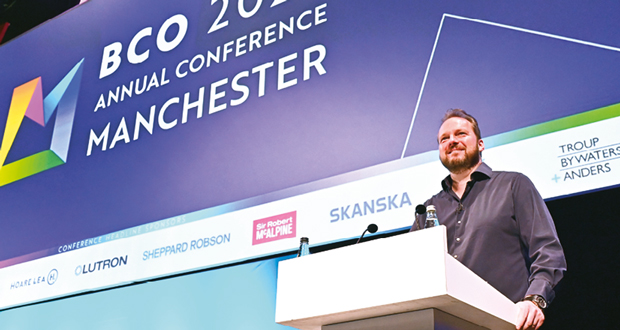The 2022 British Council for Offices Annual Conference brought together stakeholders in the development, investment and occupation of buildings to discuss the challenges ahead for the office sector
To remain relevant we need to evolve, said BCO President and Conference Chair, Mark Kowal of Sheppard Robson to the gathering of occupiers, investors, developers, designers, constructors and suppliers at the BCO conference which took place in Manchester in June.
The host city experienced a resurgence in recent years and Joanne Roney OBE, Chief Executive, Manchester City Council was on hand to outline its vision. She described the work being done to support innovation and the green economy in Greater Manchester, with a focus on a public transport system that delivers a seamless travel experience. She also disclosed that there is an influx of global companies to the city, with over half of the office developments currently in the developmental pipeline pre-let.
Roney added that to attract talent, we need workplaces that offer more than a desk; a topic tackled by a panel of developers in a session chaired by Rebecca Heron, Head of Development and Strategy, Manchester City Council.
Martyn Evans, Creative Director, U+I said that the developer’s main job is to create the right places for people so “if we’re having a tough time getting people back, we have to inspire them.” He argued that offices must be welcoming, collaborative and inspiring, and to deliver this “our job Is to understand what people want to do in the office.”
Summing up the facilities challenge, Chris Ogelsby, Chief Executive, Bruntwood referred to the “flexibility and amenity arms race” where workplaces are deployed as a destination that offers a range of amenities, from gyms and cafés to flexible and collaborative spaces.
GAME CHANGER, OR GAME OVER?
Taking a global approach to the economic, social and political scene was a stellar panel comprising, Bronwen Maddox, Director, Institute for Government, the Rt Hon Alan Johnson and Anne McElvoy, Senior Editor at the Economist.
The session, which was chaired by Richard Kauntze, Chief Executive, BCO was a sobering reminder of the disruption and uncertainty following Brexit, the pandemic and now the war in Ukraine. Summarising just some of the challenges which will impact the economy and society, the panel reflected that huge global forces, including migration on a scale the world hasn’t seen, bringing with it huge environmental challenges is changing the world and how people organise themselves.
Digital technology does offer some hope that we can overcome this uncertainty and create places where people can excel, suggested a panel comprising an occupier, landlord, provider and connectivity expert Sanjaya Ranasinghe of WiredScore, who described SMART technology as “about making places where people can excel.”
Commented Jonathan Munkley of WSP, SMART has become a buzz word but there’s a lot of confusion on what is meant by it, but in simple terms “it’s got to be about engaging with the client and with the users to find out how they’re using an asset.”
Tom Gould of Skanska, said SMART buildings offer both landlords and facilities managers information on how a building is performing, enabling them to monitor assets remotely for both reactive, preventative and predictive maintenance, as well as helping to meet net zero challenges.
FUTURE OFFICE
A discussion on the design of the Future Office centred around three key stakeholder perspectives, a developer/landlord, an architect, and an occupier. One of their most thought-provoking predictions for the long-term future of the workplace was that in 10 years, you might walk through any office door to one massive coworking zone, to enjoy social interaction as well as a focused place to work.
Transforming building occupancy, a session previewed(i) in FMJ, is predicated on us accepting, said Chair Despina Katsikakis, Global Head of Total Workplace, Cushman & Wakefield, “that work doesn’t happen in a single place. Our industry has to accept the challenge and define the purpose and value of the office because if we are complacent and just go back to the way things where, it’ll be game over.”
Given the fight for talent and the positive experience of many home workers, the balance of power has shifted, said Paul Casey, Director, IBM EMEA Global Real Estate. This means that despite misgivings on hybrid working by corporate leaders, employers must embrace changing work patterns that are acceptable to the workforce, even if not for the CEO.
Using the mantra ‘test and learn’, Andy McBain, Head of Future of Workspace & Design, Natwest Group, provided an invaluable tick list for an inviting workplace. As just about every meeting is hybrid, invest in touchscreen tech for meeting rooms; food should be used as an anchor; as is hosting events that draw people back in. And when people do come back into the workplace give them the digital tools/apps to book everything from a space to a coffee.
Referring to the BCO conference’s broad audience – comprising those who design, build, as well as manage office space, Vernon Blunt, Global Workplace Operations Director, Ericsson concluded that to successfully manage changed working patterns, and achieve sustainability as well as ESG goals, requires a collaborative approach. Judging by the consensus of the stakeholders on stage and on the conference floor, the sector is ready for the challenge.





